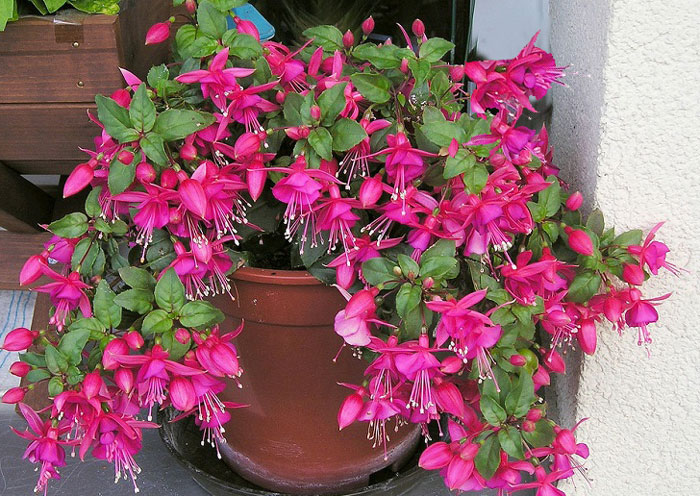How To Grow And Care For A Fuchsia Plant
Fuchsia Plants: How To Grow And Care For Fuchsias Are you looking for a beautiful and versatile plant to brighten up your garden? Look no further than the fuchsia plant! With their vibrant and eye-catching blooms, fuchsias are a popular choice for gardeners around the world. In this article, we will walk you through everything you need to know about growing and caring for these stunning plants. Plant Attributes Fuchsias are native to Central and South America, where they grow as small shrubs or trees. Most fuchsia varieties grow best in moist and well-draining soil, with partial shade to filter the intense sunlight. Fuchsias also prefer humid conditions, making them an ideal choice for greenhouse or indoor growing. One of the most striking features of fuchsia plants is their beautiful and unique flowers. Fuchsia blooms typically come in shades of pink, purple, red, and white. The flowers are usually bell-shaped, with long, thin petals that give them a delicate and graceful appearance. Plant Care Healthy fuchsia plants require regular maintenance and care. Here are some tips to keep your fuchsias healthy and thriving: - Water: Fuchsias require regular watering, especially during the hot summer months. Make sure to keep the soil consistently moist, but not waterlogged. Avoid getting water on the leaves, as this can cause fungal diseases. - Fertilizer: Fuchsias need regular feeding to thrive. Use a high-quality, balanced fertilizer every two weeks during the growing season. Be careful not to overfeed, as this can lead to burned roots and foliage. - Pruning: Fuchsias should be pruned regularly to promote healthy growth and control their size and shape. Prune in the spring, just before new growth begins. Cut back any dead or damaged branches, as well as any branches that are growing out of bounds. Propagation Fuchsias are relatively easy to propagate through stem cuttings. Here's how to do it: - Take a cutting: Choose a healthy stem from the mother plant and cut it with sharp, clean shears. - Remove leaves: Strip off the lower leaves, leaving only the top two to three pairs. - Dip in rooting hormone: Dip the cutting in rooting hormone to encourage root growth. - Plant in soil: Plant the cutting in moist, well-draining soil and keep it in a warm, humid location. - Wait for roots: Within a few weeks, the cutting should develop roots and begin to grow. Potting & Repotting Fuchsias are excellent container plants and can thrive in small spaces like balconies or patios. Here's how to pot and repot your fuchsias: - Choose a container: Select a container that is large enough to accommodate the root system of your fuchsia plant. - Add soil: Fill the container with well-draining potting soil. - Plant the fuchsia: Remove the plant from its original container and place it in the new container, making sure the top of the root ball is level with the soil. - Water: Water the plant thoroughly after potting, and keep the soil consistently moist. - Repotting: Fuchsias should be repotted every two to three years to prevent root-bound plants. Repot in the spring before new growth begins. Commons Pests & Plant Disease Like any plant, fuchsias are susceptible to pests and diseases. Here are some of the most common issues and how to address them: - Aphids: These small insects feed on sap and can cause yellowing of leaves and stunted growth. Use insecticidal soap or neem oil to control aphids. - Whiteflies: These tiny, white insects also feed on sap and can cause leaf yellowing and wilting. Use insecticidal soap or neem oil to control whiteflies. - Botrytis blight: This fungal disease can cause brown spots on leaves and flowers. Remove affected plant parts and apply a fungicide. Common Problems Here are some common issues that gardeners may encounter when growing fuchsias: - Dropping flowers or leaves: This can be caused by a lack of water or nutrients, overwatering, or too much sunlight. Make sure to keep your fuchsias in a consistent environment with proper water and nutrients. - Root rot: This fungal disease can occur when plants are overwatered or grown in soil that doesn't drain properly. Make sure to use well-draining soil and don't overwater. - Lack of blooms: This can be caused by inadequate sunlight or nutrition, or pruning at the wrong time. Ensure your fuchsias are getting enough light and nutrients, and prune at the right time and in the right way. In conclusion, fuchsia plants are a beautiful and versatile addition to any garden or indoor space. With proper care and maintenance, these stunning plants will thrive and reward you with long-lasting blooms year after year. We hope this article has helped you understand how to grow and care for fuchsia plants, and we encourage you to try growing these lovely plants for yourself! :max_bytes(150000):strip_icc()/fuchsia-great-container-plant-for-shade-847937-22-38c5085caf5c4f569baeef3d69d50d99.jpg)


:max_bytes(150000):strip_icc()/fuchsia-great-container-plant-for-shade-847937-22-38c5085caf5c4f569baeef3d69d50d99.jpg)
www.thespruce.com

www.naturebring.com

agreenhand.com
Post a Comment for "How To Grow And Care For A Fuchsia Plant"